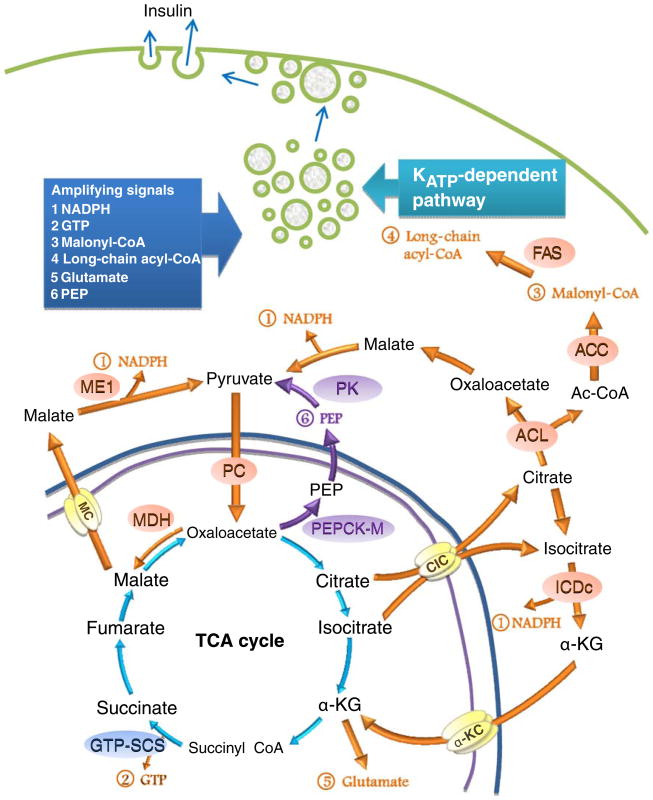Fig. 2.
Mitochondrial biochemical pathways that are involved in KATP-independent GSIS. Pyruvate enters the mitochondrion through the pyruvate transporter to undergo a PDH-catalysed reaction to form acetyl-CoA or an anaplerotic reaction catalysed by PC [29, 30]. There are two routes for oxaloacetate. The first route involves its conversion to malate, which exits the mitochondrion via the malate carrier (MC) before being converted back to pyruvate. Pyruvate is then cycled back to the mitochondrion to form the ‘pyruvate/malate cycle’ [41]. The second route involves its conversion to citrate, which exits the mitochondrion and is converted to oxaloacetate and acetyl-CoA (Ac-CoA). Acetyl-CoA is converted to malonyl-CoA and long-chain acyl-CoA, while ME oxaloacetate is converted to malate and pyruvate by malate dehydrogenase and cytosolic ME, respectively, as part of the ‘pyruvate/citrate cycle’ [40]. Citrate in the mitochondrion can be converted to isocitrate, which exits the mitochondrion through the citrate/isocitrate carrier (CIC) to the cytoplasm, where it is further converted to α-ketoglutarate (α-KG) by NADP-dependent isocitrate dehydrogenase (ICDc). α-Ketoglutarate then re-enters the mitochondrion as part of the ‘pyruvate/isocitrate’ cycle [62]. The above three cycles share the common terminal step, i.e. the conversion of malate to pyruvate concomitant with the production of cytosolic NADPH by cytosolic ME. Among other amplifying signals, NADPH is thought to be the consensus factor for KATP-independent GSIS. Oxaloacetate may be removed from the mitochondrion as PEP by PEPCK-M. Cytosolic PEP is converted to pyruvate by pyruvate kinase before being recycled back to the mitochondrion [65]. Other amplifying signals include mitochondrial GTP produced by GTP-SCS, and glutamate produced by GDH. NADPH, GTP, malonyl-CoA, long-chain acyl-CoA, glutamate and PEP are thought to be the amplifying signals that control the KATP-dependent pathway. These amplifying signals are suggested to drive exocytosis of insulin granules

